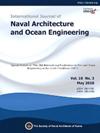Finite-element analysis on the parameters influencing the brittle crack arrest in steel plates
IF 3.9
3区 工程技术
Q2 ENGINEERING, MARINE
International Journal of Naval Architecture and Ocean Engineering
Pub Date : 2025-01-01
DOI:10.1016/j.ijnaoe.2025.100659
引用次数: 0
Abstract
With increasing strength and thickness of steel plates, the susceptibility to brittle fracture also grows, primarily due to the reduction in toughness of both the base metal and the weld zone. To maintain structural integrity and mitigate fracture risks in thick, high-strength steels—especially in applications such as ship hulls—advanced design strategies and materials with enhanced brittle crack arrestability have been introduced. The arrest performance is typically assessed by determining the brittle crack arrestability value (Kca) through large-scale experimental methods. However, due to the high cost, time, and equipment demands of such tests, alternative approaches using small-scale specimens and numerical simulations have been actively investigated to estimate Kca more efficiently. This study establishes an analytical model by conducting a parametric investigation of the key factors influencing Kca determination. The analysis incorporates yield stress variations influenced by temperature gradients, strain rates, and thermal effects, considering Young's modulus and strain rate dependency. Additionally, the study examines the influence of crack-growth increments and the impact energy effect on brittle crack initiation (KIC). The reliability of the proposed model is validated by comparing its Kca predictions with experimental results obtained from the ESSO test.
影响钢板脆性裂纹止裂参数的有限元分析
随着钢板强度和厚度的增加,脆性断裂的敏感性也增加,这主要是由于母材和焊缝区的韧性降低。为了保持高强度厚钢的结构完整性并降低断裂风险,特别是在船体等应用中,采用了先进的设计策略和具有增强脆性抗裂性的材料。典型的止裂性能评价方法是通过大规模实验方法确定脆性裂纹止裂值(Kca)。然而,由于这种测试的高成本、时间和设备需求,人们一直在积极研究使用小规模样本和数值模拟的替代方法,以更有效地估计Kca。本研究通过对影响Kca测定的关键因素进行参数化调查,建立了分析模型。该分析纳入了受温度梯度、应变率和热效应影响的屈服应力变化,并考虑了杨氏模量和应变率的依赖性。此外,研究了裂纹扩展增量和冲击能量对脆性裂纹起裂的影响。通过将该模型的Kca预测结果与ESSO试验结果进行比较,验证了该模型的可靠性。
本文章由计算机程序翻译,如有差异,请以英文原文为准。
求助全文
约1分钟内获得全文
求助全文
来源期刊

International Journal of Naval Architecture and Ocean Engineering
ENGINEERING, MARINE-
CiteScore
4.90
自引率
4.50%
发文量
62
审稿时长
12 months
期刊介绍:
International Journal of Naval Architecture and Ocean Engineering provides a forum for engineers and scientists from a wide range of disciplines to present and discuss various phenomena in the utilization and preservation of ocean environment. Without being limited by the traditional categorization, it is encouraged to present advanced technology development and scientific research, as long as they are aimed for more and better human engagement with ocean environment. Topics include, but not limited to: marine hydrodynamics; structural mechanics; marine propulsion system; design methodology & practice; production technology; system dynamics & control; marine equipment technology; materials science; underwater acoustics; ocean remote sensing; and information technology related to ship and marine systems; ocean energy systems; marine environmental engineering; maritime safety engineering; polar & arctic engineering; coastal & port engineering; subsea engineering; and specialized watercraft engineering.
 求助内容:
求助内容: 应助结果提醒方式:
应助结果提醒方式:


